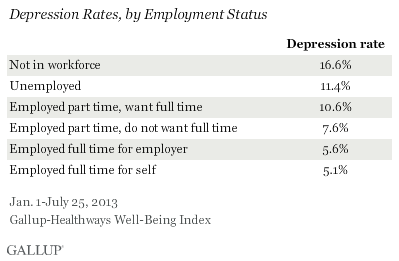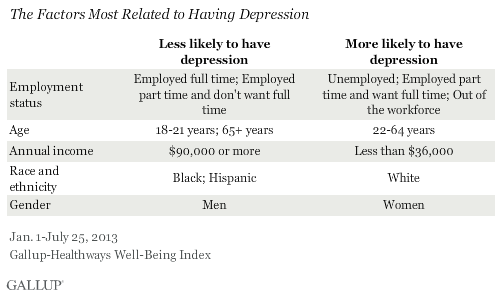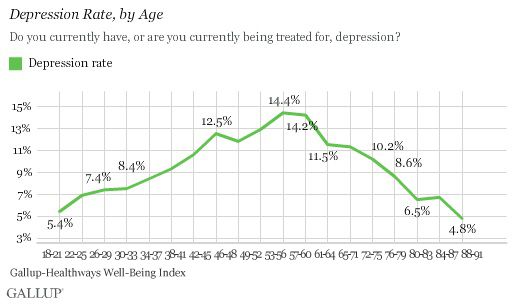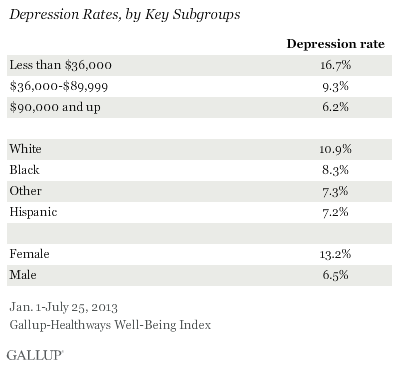WASHINGTON, D.C. -- For Americans, being unemployed, being out of the workforce, or working part time -- but wanting full-time work -- are the strongest predictor of having depression. Unemployed adults and those not working as much as they would like are about twice as likely as Americans who are employed full time to be depressed.

Americans who are not in the workforce are the most likely to be depressed, at 16.6%. It is possible that there is something about employment that contributes to lower depression rates, or it could be that those who have depression are less able to seek out and retain employment.
These findings are from surveys with more than 100,000 Americans, conducted as part of the Gallup-Healthways Well-Being Index from Jan. 1-July 25, 2013. Gallup asks Americans if they have ever been diagnosed with depression and, if so, whether they currently have it. Overall, 10% of U.S. adults say they have been diagnosed with and currently have depression, which is consistent with the U.S. Centers for Disease Control and Prevention's estimated depression rate.
Gallup uncovered the employment-depression connection by conducting an analysis of the correlates of depression. The analysis looked at Americans who currently have depression, while simultaneously controlling for 12 variables: age, gender, income, education, race and ethnicity, marital status, having children, region, employment status, obesity, having health insurance, and being a caregiver. This means that Gallup could examine each factor independently to find out which is most strongly linked to depression.
Beyond employment, the factors most related to having depression are being aged 22 to 64 years, earning less than $36,000 per year, being white, and being female. Conversely, those who are very young, older, black, Hispanic, male, or who earn at least $90,000 per year are less likely to have depression after taking all other factors into account.

The analysis also shows that being obese, a caregiver, living in the West, and not having kids are moderate predictors of depression among Americans.
On the other hand, lacking a college degree; being separated, divorced, or widowed; and being uninsured are not strongly or moderately related to having depression once other factors are taken into account.
Depression Peaks in Middle Age
Young adults aged 18 to 21 years, at 5.4%, are among the least likely be depressed. The depression rate generally rises as Americans age, peaking in the 57-60-year and 61-64-year age groups, at 14.4% and 14.2%, respectively. Thereafter, depression falls off, lessening dramatically by age 76 to 8.6%.

Depression Decreases as Income Rises
Americans who earn less than $36,000 annually are nearly three times more likely to be depressed than those who earn more than $90,000 per year.
Separately, women are twice as likely as men to say they have depression and whites are slightly more likely than blacks and Hispanics to say they are depressed.

Implications
While one in 10 Americans currently have depression, this analysis shows that certain segments of the population are more likely to suffer from the illness than others. Americans who are unemployed, underemployed, and not in the workforce are more likely to report having depression than those who are employed full time or who are content with being employed part time. Thus, the stubborn unemployment and underemployment rates may have more than just a negative impact on the nation's economic recovery, they also may present a significant threat to Americans' mental health and well-being.
Additionally, depression among the employed has significant costs to individuals, businesses, and the overall economy. Gallup has found that depression costs U.S. employers $23 billion per year in lost productivity due to absenteeism.
Health providers, community groups, and public health officials can target depression interventions at the groups most likely to be depressed. At the same time, however, leaders can also raise awareness about depression and reduce the stigma of seeking treatment for the illness among groups who are less likely to have depression -- possibly because these groups are less willing to acknowledge having depression and to seek professional help for it.
Under the Affordable Care Act, all adults with an insurance policy beginning on or after Sept. 23, 2010, are entitled to a depression screening at no cost. Ensuring all Americans -- particularly the jobless and low-income Americans who are more likely to have depression -- are aware of this provision may be key to identifying and treating the many who suffer from this illness.
About the Gallup-Healthways Well-Being Index
The Gallup-Healthways Well-Being Index tracks well-being in the U.S. and provides best-in-class solutions for a healthier world. To learn more, please visit well-beingindex.com.
Survey Methods
Results are based on telephone interviews conducted as part of the Gallup-Healthways Well-Being Index survey Jan. 1-July 25, 2013, with a random sample of 101,195 adults, aged 18 and older, living in all 50 U.S. states and the District of Columbia.
For results based on the total sample of national adults, one can say with 95% confidence that the margin of sampling error is ±1 percentage points.
Interviews are conducted with respondents on landline telephones and cellular phones, with interviews conducted in Spanish for respondents who are primarily Spanish-speaking. Each sample of national adults includes a minimum quota of 50% cell phone respondents and 50% landline respondents, with additional minimum quotas by region. Landline and cell phone numbers are selected using random digit dial methods. Landline respondents are chosen at random within each household on the basis of which member had the most recent birthday.
Samples are weighted to correct for unequal selection probability, nonresponse, and double coverage of landline and cell users in the two sampling frames. They are also weighted to match the national demographics of gender, age, race, Hispanic ethnicity, education, region, population density, and phone status (cellphone only/landline only/both, and being cellphone mostly). Demographic weighting targets are based on the March 2012 Current Population Survey figures for the aged 18 and older U.S. population. Phone status targets are based on the July-December 2011 National Health Interview Survey. Population density targets are based on the 2010 census. All reported margins of sampling error include the computed design effects for weighting.
In addition to sampling error, question wording and practical difficulties in conducting surveys can introduce error or bias into the findings of public opinion polls.
For more details on Gallup's polling methodology, visit www.gallup.com.
